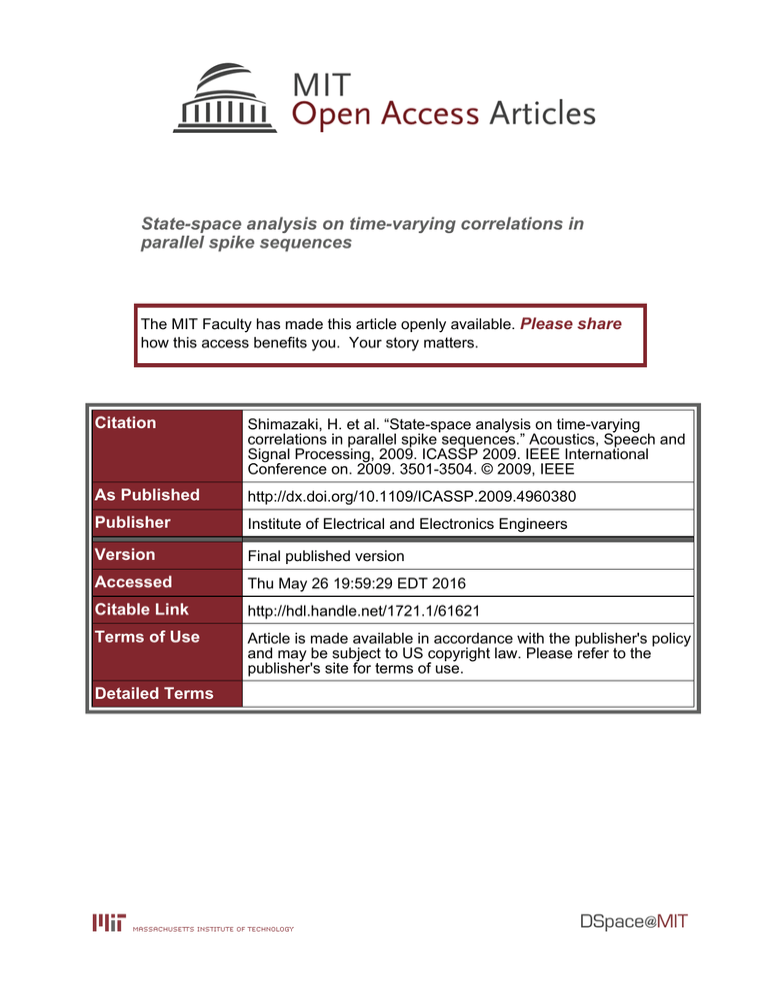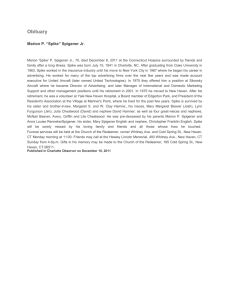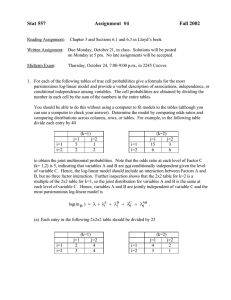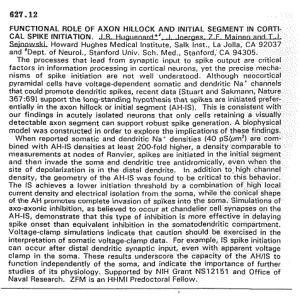State-space analysis on time-varying correlations in parallel spike sequences Please share
advertisement

State-space analysis on time-varying correlations in
parallel spike sequences
The MIT Faculty has made this article openly available. Please share
how this access benefits you. Your story matters.
Citation
Shimazaki, H. et al. “State-space analysis on time-varying
correlations in parallel spike sequences.” Acoustics, Speech and
Signal Processing, 2009. ICASSP 2009. IEEE International
Conference on. 2009. 3501-3504. © 2009, IEEE
As Published
http://dx.doi.org/10.1109/ICASSP.2009.4960380
Publisher
Institute of Electrical and Electronics Engineers
Version
Final published version
Accessed
Thu May 26 19:59:29 EDT 2016
Citable Link
http://hdl.handle.net/1721.1/61621
Terms of Use
Article is made available in accordance with the publisher's policy
and may be subject to US copyright law. Please refer to the
publisher's site for terms of use.
Detailed Terms
STATE-SPACE ANALYSIS ON TIME-VARYING CORRELATIONS
IN PARALLEL SPIKE SEQUENCES
Hideaki Shimazaki1 , Shun-ichi Amari1 , Emery N. Brown2,3 , and Sonja Grün1
1
Theoretical Neuroscience Group, RIKEN Brain Science Institute, Wako-shi, Saitama, Japan
2
Anesthesia and Critical Care, Massachusetts General Hospital, Boston, MA, USA
3
Harvard-MIT Division of Health Sciences and Technology, Cambridge, MA, USA
ABSTRACT
A state-space method for simultaneously estimating timedependent rate and higher-order correlation underlying parallel spike sequences is proposed. Discretized parallel spike
sequences are modeled by a conditionally independent multivariate Bernoulli process using a log-linear link function,
which contains a state of higher-order interaction factors. A
nonlinear recursive filtering formula is derived from a logquadratic approximation to the posterior distribution of the
state. Together with a fixed-interval smoothing algorithm,
time-dependent log-linear parameters are estimated. The
smoothed estimates are optimized via EM-algorithm such
that their prior covariance matrix maximizes the expected
complete data log-likelihood. In addition, we perform model
selection on the hierarchical log-linear state-space models
to avoid over-fitting. Application of the method to simultaneously recorded neuronal spike sequences is expected to
contribute to uncover dynamic cooperative activities of neurons in relation to behavior.
Index Terms— State space methods, Point processes,
Generalized linear model, Correlation, Information geometry
1. INTRODUCTION
Classical studies in neurophysiology are based on the idea
that stimulus information is encoded in the firing rates of single neurons. Alternatively, precise spike coordination is discussed as an indication of coordinated network activity in
form of a cell assembly [1] relevant for information processing. Activation of a cell assembly predicts higher-order correlation (HOC) between the spiking activities of its member
neurons [2]. Supportive evidence for this concept was provided by existence of excess synchrony among neuronal spiking activities occurring dynamically in relation to behavioral
context [3, 4, 5]. However, available approaches for correlation analysis do not allow for identifying time-dependent
HOCs to trace active assemblies.
To characterize higher-order interaction, the log-linear
model is an useful tool because it provides a well-defined
measure of correlation based on information geometry [6].
978-1-4244-2354-5/09/$25.00 ©2009 IEEE
3501
Although its natural (canonical) parameters are not orthogonal, HOCs can be extracted in a quasi-orthogonal manner
from a mixture of dually affine Riemannian coordinates [7, 8].
Former studies performed a regression analysis on parallel
spike trains using either a log-linear model [7, 8, 9], or the
log-linear model considering up to pairwise interaction only
(maximum entropy model) [10] to characterize neuronal data.
The existing approaches, however, assume stationarity, a condition that is typically not fulfilled in neuronal spike data
from awake behaving animals.
The state-space method [11] was suggested as a framework to model a time-dependent system by representing its
parameters (states) as a Markov process. It allows to estimate a filtered/smoothed posterior distribution of the timedependent state conditional on observed data. The approximation method for non-Gaussian point process observation
in a recursive filtering algorithm was successfully applied to
neuronal spike data [12, 13, 14]. Existing state-space models
incorporated ensembles of spike histories into the univariate
spike response model [14, 15], however, without considering
correlations between the spike sequences.
In this contribution, we provide a method for estimating
the dynamics of HOCs by combining the log-linear model
with a state-space analysis. For that estimation, we combined
a fixed-interval smoother [11] with a nonlinear recursive filtering algorithm which we derived from a log-quadratic approximation of the posterior distribution. To obtain the most
predictive model, we compared goodness-of-fit of hierarchical log-linear state-space models with different order of interactions by using the Akaike’s Bayesian information criterion
(ABIC) [16]. While inclusion of increasingly higher-order interaction terms improves the model accuracy, the estimation
of higher-order parameters may suffer large variance due to
the paucity of synchronous spikes in the data. This trade-off is
optimally resolved with the model that minimizes the ABIC.
The model complexity is thus selected based on the sample
size as well as the prominence of higher-order structure.
An earlier version of this paper was presented in abstract
form [Shimazaki, Brown, Grün, Statistical Analysis of Neuronal Data 4, Pittsburgh, May 2008].
ICASSP 2009
2. METHODS
2.1. Log-linear model of higher-order interactions
We model N simultaneous spike sequences as a multivariate Bernoulli process. The processes, repeated over n trials, are discretized into T bins of bin size Δ. Let Xt,l =
t,l
) be N -tuple binary variables at t-th bin
(X1t,l , X2t,l , . . . , XN
of l-th trial, where 1 denotes a bin filled with one or more
spikes, and 0 denotes no spike. Let x = (x1 , x2 , . . . , xN )
represent 2N spike patterns, and Ωk be a k-subset of N elements: Ω1 = {1, 2, . . . , N } , Ω2 = {12, 13, . . .}, Ω3 =
{123, 124, . . .}, etc. We define the interaction terms across
the variables as Fi (x) = xi , Fij (x) = xi xj , Fijk (x) =
xi xj xk (1 ≤ i < j < k ≤ N ), etc. The log-linear model up
to the r-th order interaction (r ≤ N ) is defined as [6]
(r)
θit Fi (x)
(1)
log pt (x) = −ψt +
is the first order autoregressive parameters. The initial value
obeys θ1 ∼ N (μ, Σ); μ (d × 1 matrix) and Σ (d × d matrix).
We denote the set of hyper-parameters w = [F, Q, μ, Σ].
The joint probability distribution is obtained by combining the observation equation (Eq. 4) and the state equation
(Eq. 5). The optimization principle for w is chosen as the
maximization of the marginal log-likelihood,
(6)
l (w) = log p (y1:T , θ 1:T |w) dθ 1:T .
We make use of the expectation-maximization (EM) algorithm known to efficiently combining the estimation of the
posterior density and the optimization of the hyper-parameter.
Instead of Eq. 6, the method maximizes its lower bound,
Q (w|w∗ ) = E [log p (y1:T , θ 1:T |w) |y1:T , w∗ ]
i∈{Ω1 ,...,Ωr }
θit
with ψt being a normalization parameter.
is a natural parameter referring to an interaction among variables indicated
t
t
in theindex i. Let θ t = [θ1t , . . . , θ12
, . . . , θ1···r
, . . .] be a
r
N
d = k=1 k dimensional vector. Our goal is to obtain the
estimate of θ t from the observed parallel spike sequences.
The log-linear model belongs to the exponential family
which defines a dually flat space [6]. Its e-affine coordinate is
given as the natural parameter θ t , its m-affine coordinates as
t
t
, . . . , η1···r
, . . .] ,
the expectation parameter η t = [η1t , . . . , η12
where
(2)
ηit = E [Fi (x) |θ t ]
for i ∈ {Ω1 , . . . , Ωr }. An efficient estimator of ηit is the synchrony rate defined for the t-th bin as
yit =
n
1 t,l Fi X
n
(3)
l=1
for i ∈ {Ω1 , . . . , Ωr }. Synchrony rates up to the r-th order,
t
t
, . . . , y1···r
, . . .] , constitute sufficient statisyt = [y1t , . . . , y12
tic of the log-linear model up to the r-th order interaction.
2.2. State-space analysis on the log-linear model
Assuming conditionally independent observations, the likelihood of observed spike sequences is given as
p (y1:T |θ 1:T ) =
T
exp [n (yt θ t − ψt )] ,
(4)
=n
√
√
−d log 2π − log det Σ
1
− E (θ 1 − μ) Σ−1 (θ 1 − μ)
2
√
− (T − 1) d log 2π − (T − 1) log det Q
T
−
for t = 2, . . . , T . A random vector ξ t (d × 1 matrix) is drawn
from a zero-mean multivariate normal distribution with a covariance matrix Q (d × d matrix). A matrix F (d × d matrix)
3502
1
E (θ t − Fθ t−1 ) Q−1 (θ t − Fθ t−1 ) , (7)
2 t=2
by alternating expectation (E) and maximization (M) steps. In
the E-step, we obtain the expected values with respect to θ t
in Eq. 7 using w∗ . In the M-step, the hyper-parameter w that
maximizes Eq. 7 is obtained. The obtained w is then used for
w∗ in the next E-step. The details of each step are given as
follows.
E-step Mean and covariance of the one-step prediction
density p (θ t |y1:t−1 ) for the Gaussian state transition is given
as [11, 12, 13]
θ t|t−1 = Fθ t−1|t−1 ,
Wt|t−1 = FWt−1|t−1 F + Q.
(8)
(9)
Here θ t|s and Wt|s are the conditional mean E [θ t |y1:s ] and
covariance E[(θ t − θ t|s )(θ t − θ t|s )|y1:s ]. The filter distribution is given by the Bayes’ theorem as
p (yt |θ t , y1:t−1 ) p (θ t |y1:t−1 )
p (yt |y1:t−1 )
∝ exp[n (yt θ t − ψt )
−1 1
θ t − θ t|t−1 ].
− θ t − θ t|t−1 Wt|t−1
2
p (θ t |y1:t ) =
with y1:T = {y1 , y2 , . . . , yT } and θ 1:T = {θ 1 , θ 2 , . . . , θ T }.
Our prior assumption is the following state equation
(5)
(yt Eθ t − Eψt )
t=1
t=1
θ t = Fθ t−1 + ξ t ,
T
(10)
Here we make a Gaussian approximation to the posterior by Laplace’s method: the posterior mean, θ t|t , is ob∂
log p (θ t |y1:t ) = 0; the covariance is given
tained from ∂θ
t
2
as −[ ∂θ∂t ∂θ log p (θ t |y1:t ) |θt =θt|t ]−1 . Note that the first
t
Trial, l
A
Estimated log-linear parameters
0
θ3t
−2
t
θ2
−4
Variable X t,l
1
−6
6
5
20
50
t
θ23
0
t
θ12
t,l
Variable X 2
100
Trial, l
t
θ1
50
100
Trial, l
B
Spike Sequences
5
20
t
θ13
−6
5
20
t
θ123
6
50
0
t,l
Variable X 3
100
1
Bin t [Δ]
−4
500
1
500
Bin t [Δ]
Fig. 1. (A) Simulated parallel spike sequences, Xt,l . According to a time-dependent formulation of the log-linear model (see
dashed lines in B for the model parameters), N = 3 parallel spike sequences were simulated repeatedly for n = 100 trials
(duration: T = 500 bins of width Δ = 1[ms]). Each of the 3 panels show the spike events for the 3 variables X1t,l , X2t,l , X3t,l
(t = 1, . . . , T and l = 1, . . . , n). Synchronous spikes across all 3 simultaneous sequences (detection in bins of 1ms width) are
marked with circles. Horizontal lines indicate trial numbers l = 5, 20, 50, 100. (B) Smoothed estimates of the log-linear parameters, θ t|T . The different panels show the smoothed estimates (solid lines) of the log-linear parameters θit of different orders
(i ∈ {Ω1 , Ω2 , Ω3 }) derived from the data shown in A. The gray band indicates the 99% credible interval of the marginalized
posterior density of the state (see text). The dashed lines show the true time-dependent parameters used for the generation of
the spike sequences.
derivative of the moment generating function provides the ext
pectation parameter ∂ψ
∂θ t = η t . The second derivative is the
∂ 2 ψt
∂θ t ∂θ t
ηωt i ∪ωj
−ηωt i ηωt j ,
Wt−1,t|T = E[ (θ t−1 − θ t−1|T )(θ t − θ t|T ) y1:T ]
(16)
= At−1 Wt|T .
(11)
M-step Given θ t|T , Wt|T , Wt−1,t|T , the update of w is
given by the following equations. The covariance matrix Q
and the auto-regressive parameter F are updated according to
Fisher metric
= Gt . Here (Gt )ij =
where ωi is an index of the ith element of η t . Hence we obtain the equations for the filtered mean and covariance as
θ t|t = θ t|t−1 + nWt|t−1 (yt − η t|t ),
−1
Wt|t
=
−1
Wt|t−1
+ nGt .
method of De Jong and Mackinnon [17]:
(12)
Eq. 11 is solved by the Newton-Raphson method. Together
with the one-step prediction formulae Eqs. 8 and 9, we evaluate the nonlinear recursion formulae Eqs. 11 and 12 for t =
2, . . . , T , by using the initial values θ 1|0 = μ and W1|0 = Σ.
Starting from θ T |T and WT |T obtained by the filtering
algorithm, the following fixed-interval smoothing algorithm
[11, 12, 13] provides the smoothed mean and covariance. For
t = T − 1, T − 2, . . . 2, we compute
(13)
θ t|T = θ t|t + At θ t+1|T − θ t+1|t ,
Wt|T = Wt|t + At Wt+1|T − Wt+1|t At .
(14)
T
Q=
1 [Wt|T − Wt−1,t|T F
T − 1 t=2
− FWt−1,t|T + FWt−1|T F ]
T
+
1 θ t|T − Fθ t−1|T θ t|T − Fθ t−1|T (17)
T − 1 t=2
and
F=
T Wt−1,t|T +
θ t|T θ t−1|T
t=2
·
T Wt−1|T +
θ t−1|T θ t−1|T
−1
.
(18)
t=2
with
−1
At = Wt|t F Wt+1|t
.
(15)
The lag-one covariance smoother Wt−1,t|T is obtained by the
3503
The mean of the initial distribution is updated with μ = θ 1|T .
The covariance matrix Σ is not updated. Instead, we use a
nominal diagonal matrix as Σ.
Table 1. The ABIC of the r-th order log-linear model applied
to data of different number of trials n (data shown in Fig.1-A).
The asterisk indicates the model that minimizes the ABIC.
n=5
n = 20
n = 50
n = 100
n = 200
r=1
2085∗
7913
19263
38478
76683
r=2
2097
7698∗
18542
36811
73330
r=3
2144
7728
18540∗
36781∗
73238∗
4. CONLUSION
We developed a method for identifying the time-varying
higher-order correlation structure in parallel spike sequences.
Its application to simultaneous recordings of neuronal activity
is expected to provide us with new insights into the dynamics of assembly activities, their composition and behavioral
relevance.
Acknowledgements This work was supported in part by JSPS Research Fellowships for Young Scientists (HS), R01 MH59733 / DP1
OD 003646 (EB), and RIKEN Strategic Programs for R&D (SG).
5. REFERENCES
2.3. Model Selection
Let us define a log-linear state-space model with up to the
r-th order interaction by Er . Since Er is a submanifold of
Er+1 , the log-linear models naturally form hierarchical structure, E1 ⊂ E2 ⊂ · · · ⊂ EN . Comparison of the hierarchical
models is performed by computing the ABIC [16]:
ABIC = −2l (w) + 2 dim w.
(19)
The marginal log-likelihood is computed by using the onestep prediction formula for the mean Eq. 8 as l(w) =
T
T
t=1 log p(yt |y1:t−1 , w) ≈ n
t=1 (yt θ t|t−1 − ψt|t−1 ).
3. RESULTS
We applied the method to N = 3 parallel spike sequences
with n = 100 repetitions (Fig.1-A), generated by a timedependent log-linear model (Fig.1-B, dashed lines). Figure
1-B (solid lines) shows the estimates of the log-linear parameters from the data in Figure 1-A. The gray band is the
99% credible interval of the marginalized posterior distribution p (θit | y1:T ) for i ∈ {Ω1 , Ω2 , Ω3 }. Note that parameter
t
indicates triplewise correlation, i.e. excess synchrony
θ123
compared to expectation given pairwise correlations.
While the full model (E3 ) is an unbiased model for the
triple binary sequences, the fitted parameter for the triplewise
t
may suffer large variance (over-fitting) due
correlation θ123
to the paucity of triplet synchrony. Thus a submodel with
r < 3 can be close to the generative model in terms of the
Kullback-Leibler risk. To validate that the inclusion of the
triplewise correlation improves the goodness-of-fit, we computed the ABICs for the hierarchical models (r = 1, 2, 3) as
shown in Table 1. To test the influence of the sample size
of the data upon the model selection, we varied the number
of trials n used to fit the hierarchical log-linear models. For
small number of trials (n = 5), the model without correlation structure was selected. With increasing trial numbers,
models with increasing correlation orders were selected. For
n = 50, 100, and 200, the full model predicts best.
3504
[1] D. O. Hebb, The Organization of Behavior: A Neuropsychological Theory, Wiley, New York, 1949.
[2] S. Grün et al. “Impact of higher-order correlations on coincidence distributions of massively parallel data.,” in Lect Notes
Comput Sc, vol. 5286, pp. 96-114, Nov 2008
[3] E. Vaadia et al. “Dynamics of neuronal interactions in monkey
cortex in relation to behavioral events,” Nature, vol. 373, no.
6514, pp. 515–518, Feb 1995.
[4] A. Riehle et al. “Spike synchronization and rate modulation
differentially involved in motor cortical function,” Science, vol.
278, no. 5345, pp. 1950–1953, Dec 1997.
[5] S. Grün et al.“Unitary events in multiple single-neuron spiking
activity: II. nonstationary data.,” Neural Comput, vol. 14, no.
1, pp. 81–119, Jan 2002.
[6] S.-I. Amari and H. Nagaoka, Methods of Information Geometry , American Mathematical Society, 2000.
[7] S.-I. Amari, “Information geometry on hierarchy of probability distributions,” IEEE Trans. Inf. Theory, vol. 47, no. 5, pp.
1701–1711, Jul 2001.
[8] H. Nakahara and S.-I. Amari, “Information-geometric measure
for neural spikes.,” Neural Comput, vol. 14, no. 10, pp. 2269–
2316, Oct 2002.
[9] L. Martignon et al. “Detecting higher-order interactions among
the spiking events in a group of neurons.,” Biol Cybern, vol.
73, no. 1, pp. 69–81, Jun 1995.
[10] E Schneidman et al. “Weak pairwise correlations imply
strongly correlated network states in a neural population.,” Nature, vol. 440, no. 7087, pp. 1007–1012, Apr 2006.
[11] G. Kitagawa and W. Gersch, Smoothness Priors Analysis of
Time Series, Springer-Verlag, New York, 1996.
[12] E. N. Brown et al. “A statistical paradigm for neural spike train
decoding applied to position prediction from ensemble firing
patterns of rat hippocampal place cells.,” J Neurosci, vol. 18,
no. 18, pp. 7411–7425, Sep 1998.
[13] A. C. Smith and E. N. Brown, “Estimating a state-space model
from point process observations.,” Neural Comput, vol. 15, no.
5, pp. 965–991, May 2003.
[14] W. Truccolo et al. “A point process framework for relating
neural spiking activity to spiking history, neural ensemble, and
extrinsic covariate effects.,” J Neurophysiol, vol. 93, no. 2, pp.
1074–1089, Feb 2005.
[15] M. Okatan et al. “Analyzing functional connectivity using a
network likelihood model of ensemble neural spiking activity.,” Neural Comput, vol. 17, no. 9, pp. 1927–1961, Sep 2005.
[16] H. Akaike, “Likelihood and the Bayes procedure,” in Bayesian
Statistics, University Press, pp. 143–166, 1980.
[17] P. De Jong and M. J. Mackinnon, “Covariances for smoothed
estimates in state space models,” Biometrika, vol. 75, pp. 601–
602, Sep 1988.




